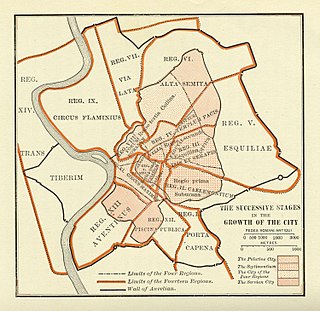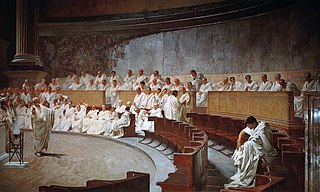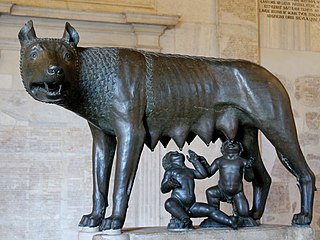
The Roman Kingdom was the earliest period of Roman history when the city and its territory were ruled by kings. According to oral accounts, the Roman Kingdom began with the city's founding c. 753 BC, with settlements around the Palatine Hill along the river Tiber in central Italy, and ended with the overthrow of the kings and the establishment of the Republic c. 509 BC.

The Senate was the governing and advisory assembly of the aristocracy in the ancient Roman Republic. It was not an elected body, but one whose members were appointed by the consuls, and later by the censors. After a Roman magistrate served his term in office, it usually was followed with automatic appointment to the Senate. According to the Greek historian Polybius, the principal source on the Constitution of the Roman Republic, the Roman Senate was the predominant branch of government. Polybius noted that it was the consuls who led the armies and the civil government in Rome, and it was the Roman assemblies which had the ultimate authority over elections, legislation, and criminal trials. However, since the Senate controlled money, administration, and the details of foreign policy, it had the most control over day-to-day life. The power and authority of the Senate derived from precedent, the high caliber and prestige of the senators, and the Senate's unbroken lineage, which dated back to the founding of the Republic in 509 BC. It developed from the Senate of the Roman Kingdom, and became the Senate of the Roman Empire.

The Conflictof the Orders, sometimes referred to as the Struggle of the Orders, was a political struggle between the plebeians (commoners) and patricians (aristocrats) of the ancient Roman Republic lasting from 500 BC to 287 BC in which the plebeians sought political equality with the patricians. It played a major role in the development of the Constitution of the Roman Republic. Shortly after the founding of the Republic, this conflict led to a secession from Rome by Plebeians to the Sacred Mount at a time of war. The result of this first secession was the creation of the office of plebeian tribune, and with it the first acquisition of real power by the plebeians.

The Curiate Assembly was the principal assembly that evolved in shape and form over the course of the Roman Kingdom until the Comitia Centuriata organized by Servius Tullius. During these first decades, the people of Rome were organized into thirty units called "Curiae". The Curiae were ethnic in nature, and thus were organized on the basis of the early Roman family, or, more specifically, on the basis of the thirty original patrician (aristocratic) clans. The Curiae formed an assembly for legislative, electoral, and judicial purposes. The Curiate Assembly passed laws, elected Consuls, and tried judicial cases. Consuls always presided over the assembly. While plebeians (commoners) could participate in this assembly, only the patricians could vote.

The king of Rome was the ruler of the Roman Kingdom. According to legend, the first king of Rome was Romulus, who founded the city in 753 BC upon the Palatine Hill. Seven legendary kings are said to have ruled Rome until 509 BC, when the last king was overthrown. These kings ruled for an average of 35 years.

The Roman magistrates were elected officials in Ancient Rome.

The Roman Constitution was an uncodified set of guidelines and principles passed down mainly through precedent. The Roman constitution was not formal or even official, largely unwritten and constantly evolving. Having those characteristics, it was therefore more like the British and United States common law system than a sovereign law system like the English Constitutions of Clarendon and Great Charter or the United States Constitution, even though the constitution's evolution through the years was often directed by passage of new laws and repeal of older ones.

The Roman Senate was a governing and advisory assembly in ancient Rome. It was one of the most enduring institutions in Roman history, being established in the first days of the city of Rome. It survived the overthrow of the Roman monarchy in 509 BC; the fall of the Roman Republic in the 1st century BC; the division of the Roman Empire in AD 395; and the fall of the Western Roman Empire in 476; Justinian's attempted reconquest of the west in the 6th century, and lasted well into the Eastern Roman Empire's history.

The Roman Assemblies were institutions in ancient Rome. They functioned as the machinery of the Roman legislative branch, and thus passed all legislation. Since the assemblies operated on the basis of a direct democracy, ordinary citizens, and not elected representatives, would cast all ballots. The assemblies were subject to strong checks on their power by the executive branch and by the Roman Senate. Laws were passed by Curia, Tribes, and century.

The executive magistrates of the Roman Republic were officials of the ancient Roman Republic, elected by the People of Rome. Ordinary magistrates (magistratus) were divided into several ranks according to their role and the power they wielded: censors, consuls, praetors, curule aediles, and finally quaestor. Any magistrate could obstruct (veto) an action that was being taken by a magistrate with an equal or lower degree of magisterial powers. By definition, plebeian tribunes and plebeian aediles were technically not magistrates as they were elected only by the plebeians, but no ordinary magistrate could veto any of their actions. Dictator was an extraordinary magistrate normally elected in times of emergency for a short period. During this period, the dictator's power over the Roman government was absolute, as they were not checked by any institution or magistrate.

The Constitution of the Roman Empire was an unwritten set of guidelines and principles passed down mainly through precedent. After the fall of the Roman Republic, the constitutional balance of power shifted from the Roman Senate to the Roman Emperor. Beginning with the first emperor, Augustus, the emperor and the Senate were theoretically two co-equal branches of government. In practice, however, the actual authority of the imperial Senate was negligible, as the emperor held the true power of the state. During the reign of the second emperor, Tiberius, many of the powers that had been held by the Roman assemblies were transferred to the Senate.

The Constitution of the Roman Kingdom was an unwritten set of guidelines and principles originating mainly through precedent. During the years of the Roman Kingdom, the constitutional arrangement was centered on the king, who had the power to appoint assistants, and delegate to them their specific powers. The Roman Senate, which was dominated by the aristocracy, served as the advisory council to the king. Often, the king asked the Senate to vote on various matters, but he was free to ignore any advice they gave him. The king could also request a vote on various matters by the popular assembly, which he was also free to ignore. The popular assembly functioned as a vehicle through which the People of Rome could express their opinions. In it, the people were organized according to their respective curiae. However, the popular assembly did have other functions. For example, it was a forum used by citizens to hear announcements. It could also serve as a trial court for both civil and criminal matters.

The Senate of the Roman Kingdom was a political institution in the ancient Roman Kingdom. The word senate derives from the Latin word senex, which means "old man". Therefore, senate literally means "board of old men" and translates as "Council of Elders". The prehistoric Indo-Europeans who settled Rome in the centuries before the legendary founding of Rome in 753 BC were structured into tribal communities. These tribal communities often included an aristocratic board of tribal elders, who were vested with supreme authority over their tribe. The early tribes that had settled along the banks of the Tiber eventually aggregated into a loose confederation, and later formed an alliance for protection against invaders.

The Legislative Assemblies of the Roman Kingdom were political institutions in the ancient Roman Kingdom. While one assembly, the Curiate Assembly, had some legislative powers, these powers involved nothing more than a right to symbolically ratify decrees issued by the king. The functions of the other assembly, the Calate Assembly, was purely religious. During the years of the kingdom, the People of Rome were organized on the basis of units called curiae. All of the People of Rome were divided amongst a total of thirty curia, and membership in an individual curia was hereditary. Each member of a particular family belonged to the same curia. Each curia had an organization similar to that of the early Roman family, including specific religious rites and common festivals. These curia were the basic units of division in the two popular assemblies. The members in each curia would vote, and the majority in each curia would determine how that curia voted before the assembly. Thus, a majority of the curia was needed during any vote before either the Curiate Assembly or the Calate Assembly.

The Senate of the Roman Empire was a political institution in the ancient Roman Empire. After the fall of the Roman Republic, the constitutional balance of power shifted from the Roman Senate to the Roman Emperor. Beginning with the first emperor, Augustus, the Emperor and the Senate were technically two co-equal branches of government. In practice, however, the actual authority of the imperial Senate was negligible, as the Emperor held the true power of the state. As such, membership in the senate became sought after by individuals seeking prestige and social standing, rather than actual authority. During the reigns of the first Emperors, legislative, judicial, and electoral powers were all transferred from the "Roman assemblies" to the Senate. However, since the control that the Emperor held over the senate was absolute, the Senate acted as a vehicle through which the Emperor exercised his autocratic powers.

The legislative assemblies of the Roman Empire were political institutions in the ancient Roman Empire. During the reign of the second Roman Emperor, Tiberius, the powers that had been held by the Roman assemblies were transferred to the senate. The neutering of the assemblies had become inevitable for reasons beyond the fact that they were composed of the rabble of Rome. The electors were, in general, ignorant as to the merits of the important questions that were laid before them, and often willing to sell their votes to the highest bidder.

The executive magistrates of the Roman Empire were elected individuals of the ancient Roman Empire. During the transition from monarchy to republic, the constitutional balance of power shifted from the executive to the Roman Senate. During the transition from republic to empire, the constitutional balance of power shifted back to the executive. Theoretically, the senate elected each new emperor, although in practice, it was the army which made the choice. The powers of an emperor, existed, in theory at least, by virtue of his legal standing. The two most significant components to an emperor's imperium were the "tribunician powers" and the "proconsular powers". In theory at least, the tribunician powers gave the emperor authority over Rome's civil government, while the proconsular powers gave him authority over the Roman army. While these distinctions were clearly defined during the early empire, eventually they were lost, and the emperor's powers became less constitutional and more monarchical.

The history of the Constitution of the Roman Republic is a study of the ancient Roman Republic that traces the progression of Roman political development from the founding of the Roman Republic in 509 BC until the founding of the Roman Empire in 27 BC. The constitutional history of the Roman Republic can be divided into five phases. The first phase began with the revolution which overthrew the Roman Kingdom in 509 BC, and the final phase ended with the revolution which overthrew the Roman Republic, and thus created the Roman Empire, in 27 BC. Throughout the history of the Republic, the constitutional evolution was driven by the struggle between the aristocracy and the ordinary citizens.

The history of the constitution of the Roman Empire begins with the establishment of the Principate in 27 BC and is considered to conclude with the abolition of that constitutional structure in favour of the Dominate at Diocletian's accession in AD 284.

The constitutional reforms of Julius Caesar were a series of laws to the Constitution of the Roman Republic enacted between 49 and 44 BC, during Caesar's dictatorship. Caesar was murdered in 44 BC before the implications of his constitutional actions could be realized.





